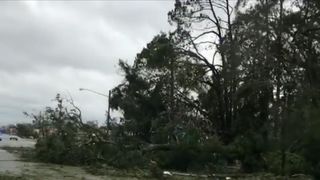Large parts of Florida have suffered "unimaginable destruction" after the third-strongest hurricane in US history slammed into the sunshine state.
More than 900,000 homes and businesses are still without power in Florida, Alabama, Georgia and the Carolinas.
Winds up to 155mph uprooted trees and brought down power lines – with federal officials warning it may be several weeks before utilities are restored to some areas.
Search and rescue teams have fanned out across affected regions to reach trapped people.
Bu the full extent of the damage was only slowly becoming clear, with some of the worst areas difficult to reach.
An 80-mile stretch of Interstate 10, the main east-west route along the Florida Panhandle – the northwestern stretch of the state which bore the brunt of Michael's strength – was closed because of debris.
At least two people have lost their lives following the category four "monster" storm which brought torrential rain and destroyed properties.
One man died when a tree fell into his home on the Florida Panhandle, and an 11-year-old girl was killed after a tree fell onto her home in Georgia.
Florida governor Rick Scott said: "This morning, Florida's Gulf Coast and Panhandle and the Big Bend are waking up to unimaginable destruction.
"So many lives have been changed forever. So many families have lost everything… This hurricane was an absolute monster."
After making landfall on Wednesday afternoon in Florida, Michael's fierce winds and heavy rain struck Georgia, where it was downgraded to a tropical storm and later reached the Carolinas.
 0:41
0:41North and South Carolina are both still recovering from Hurricane Florence, which left dozens dead and caused billions of dollars in damage last month.
Michael was expected to leave the US east coast on Friday.
More than 375,000 people up and down the Gulf Coast were ordered or urged to evacuate as Michael closed in, but it moved so fast that people did not have much time to prepare.
Red Cross officials said 7,800 people were in 100 shelters across Florida, Georgia and Alabama.
They said it was still not clear how many people stayed put and would need to be rescued.
The category four storm – the second-highest on the Saffir-Simpson hurricane intensity scale – made landfall near Mexico Beach in Florida and was just shy of a rare category five when it came ashore.
The US national guard has reached the town, dubbed "ground zero", and found 20 people who survived a direct hit from Michael.
A day after the storm hit, Mexico Beach remained very difficult to reach, with roads covered by fallen trees, power lines and other storm debris.
Aerial footage from a helicopter showed widespread devastation across the town of about 1,000 people.
 0:55
0:55Entire blocks of homes near the beach have been washed away, leaving nothing but concrete slabs in the sand.
Rows and rows of other homes were smashed to pieces or crunched to the ground.
The town was under a mandatory evacuation order as the storm targeted the coast, but some people were determined to ride out the hurricane.
More from US
Michael's intensification in the hours leading up to Wednesday caught many by surprise.
The hurricane strengthened due to the warmer than normal water temperature in the Gulf of Mexico.
[contf] [contfnew] 
Sky News
[contfnewc] [contfnewc]






